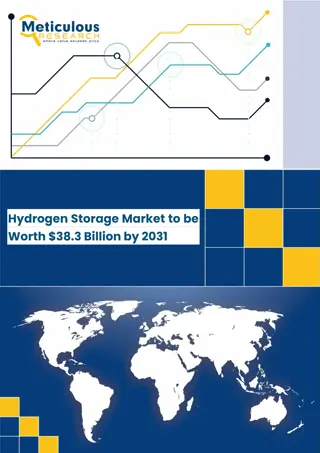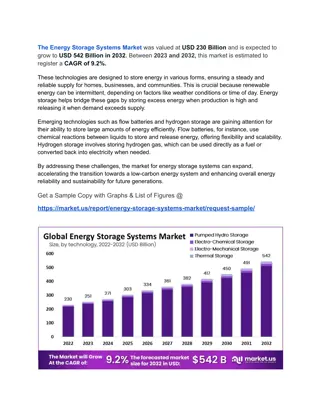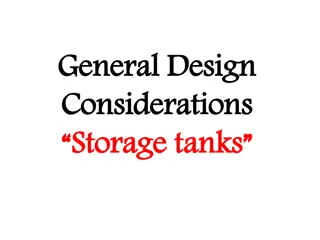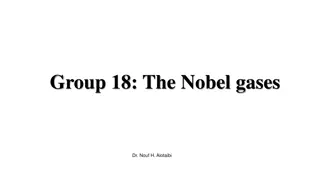Storage and Manipulation of Liquefied Gases with Dewars and Cryostats
Storage and manipulation of liquefied gases involve using specialized equipment like Dewars and Cryostats to minimize heat transfer and maintain low temperatures. Dewars, invented by James Dewar, are double-walled vacuum vessels designed to store liquefied gases with minimal losses. The use of vacuum insulation and specific materials like stainless steel helps in reducing heat transfer and maintaining the integrity of the stored gases. Factors like the configuration of Dewars, insulation methods, and construction materials play crucial roles in efficient storage and manipulation of liquefied gases.
Download Presentation

Please find below an Image/Link to download the presentation.
The content on the website is provided AS IS for your information and personal use only. It may not be sold, licensed, or shared on other websites without obtaining consent from the author. Download presentation by click this link. If you encounter any issues during the download, it is possible that the publisher has removed the file from their server.
E N D
Presentation Transcript
DEWARS AND CRYOSTATS:
Storage and manipulation of liquefied gases: So far we have seen the production of low and ultra low temperatures with the help of production of liquefied gases and other suitable procedures. It is not only sufficient to produce liquefied gases in required quantities, most importantly these liquefied gases have to be properly stored transferred from one place to another without much losses. That is to keep the evaporation rate of the liquid to minimum possible level by minimising heat transfer from warm surroundings to the cold parts of the equipment. Vacuum isolation forms a major contributor in this regard and production and maintenance of vacuum tight equipment and detecting and avoiding leaks forms a major area of research and expertise. Low temperature equipments can experience extreme stress as a consequence of large temperature gradients and differing thermal expansion coefficients of the various materials used. Dewars and Cryostats form backbone of storage and manipulation of liquefied gases.
Usually liquefied gases are stored in double walled vacuum vessels called Dewar vessels. Invented by James Dewar. Commonly these vessels are made up of glass or steel. The Dewar flask is inside a plastic or insulating cup as shown in diagram in the next slide. The Dewar flask is usually a double walled vessel with high degree of vacuum in between minimising conduction and radiation mode of heat transfer from surroundings to flask. The neck is made narrow, thick walled and very low conducting material like Ni-silver, Monel, Inconel etc., Typical loss per day in such a Dewar vessel is only about 5%. Activated charcoal will be placed at the bottom of vacuum space in order to absorb any residual gas present in between the walls.
The optimum Dewar configuration is spherical, because sphere has smallest area to volume ratio for any shape. Insulation methods: vacuum is the primary method of insulation. With the help of vacuum insulation, heat loss by conduction and radiation can be reduced effectively. Liquid nitrogen cooled shields also help in avoiding conduction, convection and radiation modes of heat transfer. Construction: Several factors have to be considered while constructing a Dewar such as thermal conductivity, surface reflectivity, outgassing rates and diffusion properties. Among the various mechanical properties of metals, brittleness is one of the important property in cryogenic work. Because many metals especially ferrite steels become very brittle just below room temperature. Hence austenitic steels (stainless steels with 16% - 26% chromium and up to 35% Nickel) and many other copper alloys are used. For piping, good strength and low thermal conductivity are necessary, of the more common materials stainless steel and Monel have these properties. Among these stainless steel have been more commonly used because of its low thermal conductivity.
CRYOSTATS: A cryostat is a device used to maintain low cryogenic temperatures of samples or devices mounted within the cryostat. In a typical cryostat, a bath of a suitable liquid is used. The requirement is that the liquid should not solidify at low temperatures required. The liquid is usually cooled by liquefied air. The temperature can be adjusted, if required, by means of an electrical current in a heater coil. There are mainly two types of cryostats. They are: 1. Bath type cryostat. 2. Continuous flow type cryostats.
Bath type cryostats: Henning cryostats: As shown in diagram, Henning cryostat contains pentane bath taken in a vacuum vessel A and is cooled by slow stream of liquid air through the porcelain U-Tube G . A stirrer E is used to keep pentane in motion thereby maintaining a steady and uniform temperature. The temperature of the bath is determined by flow rate of liquid air into G and stirring rate of stirrer E and Can be kept constant up to a few hundredths of a degree over the range 120K-273K. One main disadvantage of Henning cryostat is that pentane is highly inflammable. Hence there is a danger of explosion. However in the temperature range of 190K- 273K, this problem can be avoided by using a non-inflammable mixture of CCl4 and chloroform.
Continuous flow type cryostats: Hydrogen vapour cryostats: Continuous flow cryostats are cooled by liquid cryogens ( typically liquid nitrogen, hydrogen or helium depending on temperature range required ) from a storage Dewar. As the cryogen boils within the cryostat, it is continuously replenished by a steady flow from the storage Dewar. Temperature control of the sample within the cryostat is usually achieved by controlling the flow rate of the cryogen into the cryostat together with a heating coil attached with a temperature sensor.
This cryostat is useful for the temperature range of 20.4K to 54.7K. In this cryostat as shown in the diagram, hydrogen from a storage cylinder passes through a coil C immersed in liquid hydrogen in the vacuum vessel I, there by getting cooled to 20K. The gas then passes through a vacuum jacketed tube into vacuum vessel II. An electrical heater E is located inside this vessel II. The temperature of the gas can be raised to that temperature at which the experimental vessel II is to be maintained. The rate of flow of hydrogen gas is adjustable. The heating current can also be controlled to get a certain degree of automation. With the help of this type of arrangement a constancy of 0.01K can be achieved in the temperature of the vessel II.
Applications of cryostats: Magnetic resonance imaging and research magnet types: Cryostats used in MRI machines are designed to hold a cryogen, typically helium, in a liquid state with minimal evaporation (boil-off). The liquid helium bath is designed to keep the superconducting magnet s bobbin of superconductive wire in its superconductive state. Biological microtome type: Cryostat are used in medicine to cut histological slides. They are usually used in a process called frozen section histology. https://youtu.be/d43LFVV3h6w























